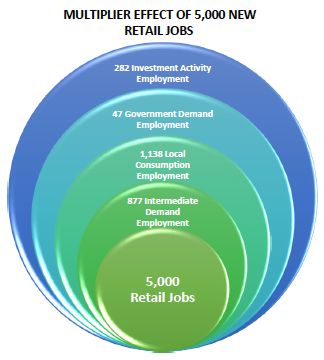SUMMARY
Firms have a ripple effect in the economy when they buy goods and services from other firms and when employees spend their earnings. This is often termed the multiplier effect. The difference in magnitude of the multiplier effect depends on a few variables—importantly, the availability of a local supply chain, the level of wages, and access to productive labor.
This brief summarizes the employment multiplier effect in 2014 of adding jobs in five industries using the REMI Tax-PI model: 5,000 professional, scientific, and technical jobs; 5,000 oil and gas extraction jobs; 5,000 computer and electronic product manufacturing jobs; 5,000 general jobs; and 5,000 retail trade jobs spread across all sectors of the economy. These scenarios assume a change from a baseline economic forecast. Growth of 5,000 jobs in oil and gas extraction and in computer and electronic product manufacturing would represent large growth on a small base of total sector employment in 2014, while growth of 5,000 jobs in retail trade; in professional, scientific, and technical services; and in all private nonfarm employment would represent relatively small growth on a large base of sector employment.
When new jobs are created, the impact is felt on the area’s economy and demographics. The demand for new jobs is either met by the existing labor force, new entrants to the labor force from the existing population, or by migration into the area. A shortage of workers leads to upward pressure on wages. High-wage industries have a greater impact on the economy as employees spend their earnings on local consumption items (e.g., house, vehicles, food, entertainment, services, etc.). As a company or industry grows, it demands goods and services from other industries. The broader impact of these supply chain purchases depends on the extent that local industries can satisfy additional demand versus how much needs to be purchased from outside the region.
When 5,000 additional oil and gas extraction jobs are added to the economy in 2014, the total impact on Colorado employment is an estimated 19,048 supported jobs, including intermediate demand, local consumption, government demand, and investment activity. Oil and gas extraction is one of the highest paying industries in the state, with average annual earnings totaling an estimated $108,000 per worker. Additionally, with this level of direct growth, the industry is expected to induce high levels of investment activity in capital goods. Growth in the computer and electronic product manufacturing sector, with average wages of $119,000, leads to employment growth of similar magnitude, having a total employment impact of 20,588 jobs in Colorado in 2014.
In contrast, adding 5,000 jobs in the retail trade sector has lower multiplier effects on employment and induces smaller impacts from capital investment activity and smaller impacts from intermediate demand. The average earnings for the retail sector is $32,721 in 2014. Retail is nonetheless an important sector to the economy, connecting consumers with goods and services demanded, and serving as a conduit for retail sales taxes. 
Investment Activity Employment: The employment needed to satisfy demand for capital goods.
Government Demand Employment: The employment needed to satisfy demand for goods and services by government expenditures.
Local Consumption Demand Employment: The employment needed to satisfy demand for consumer goods.
Intermediate Demand Employment: The employment needed to satisfy demand for material inputs to the production of final goods.
Source: REMI.
SUMMARY OF IMPACTS BY INDUSTRY
[table id=1 /]